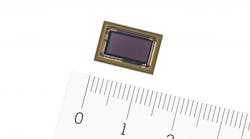The following article was originally published in ee DesignNews Europe. It is reprinted here with permission.
With its IMX324 image sensor, Sony breaks new ground in the design of automotive-grade image sensors in several ways. The sensor not only offers higher resolution than available products, it is also the first time that the stacked configuration is used for automotive-grade image chips. Plus, the image sensor offers functional safety and data security features.
The IMX324 offers a resolution of 7.42 megapixels, approximately three times the horizontal resolution of conventional products, which enables high-definition image capture of distant road signs approximately 160 meters ahead of the camera. Furthermore, the sensor has a pixel binning mode that helps raising the sensitivity in low-light environments. With its sensitivity of 2666 mV, the sensor can capture images of pedestrians and obstacles even in dark situations that are equivalent to the brightness of moonlight. To help the device to cope with uneven, mixed levels of brightness, due to headlights and streetlights when driving at night, the sensor is equipped with a function that alternately captures dark sections at high-sensitivity settings and bright sections at high resolution, enabling high-precision image recognition when combined with the signal processing of the latter stage.
This is the first time in the industry where a stacked configuration has been employed on an automotive grade sensor. This arranges the pixel array and signal processing circuit in layers to allow for a compact size and low power consumption while still delivering high resolution.
According to Sony, the new sensor is expected to be compatible with the EyeQ4 and EyeQ5 image processors currently being developed by Intel subsidiary Mobileye for use in ADAS and autonomous vehicle technology.
This sensor is planned to meet the AEC-Q100 Grade 2 reliability testing standards for automotive electronic components by June 2018, when the test and certification process will be completed. Sony has also introduced a development process compliant with ISO 26262 automobile functional safety standards, to ensure design quality that satisfies the functional safety requirements for automotive products, and this has led to its supporting functional safety requirement level ASIL B for failure detection, notification, and control. Moreover, the new sensor comes with a security feature that protects the output image from being altered, which is the industry’s first application of such a function in an image sensor for automotive cameras.

